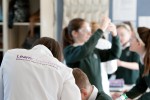The newest addition to the
Learn Chemistry resource bank is one of our older legacy materials. However, despite its age, it is still relevant and definitely worth a place on any teacher's bookshelf as a reference.
Modern Chemical Techniques provides chemistry teachers with resource materials and background information on chemical methods.
We recognise that chemistry teachers come from a variety of backgrounds, and this book caters for teachers who are familiar with modern chemical techniques, as well as for those teachers that will find them unfamiliar. The book covers much of the basic theory of the technique
without emphasising too heavily the maths or physics involved.
The topics covered include
mass spectrometry,
nuclear magnetic resonance spectroscopy,
infrared spectroscopy,
ultraviolet/visible spectroscopy,
chromatography and
electron microscopy. The final chapter,
Following a Synthetic Route, shows how spectra change as a molecule is modified to the target molecule Ibuprofen, in a chemical synthesis, including data from mass, infrared, and NMR spectral investigations.
An example of the NMR spectra from the book is shown below:
We hope the advanced reader will be able to delve into the boxed sections of each chapter, but the novice reader will not be disadvantaged by omitting them. Overall, the book should give confidence to teachers in covering, perhaps, unfamiliar techniques.
